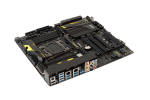10. Metodologia di prova
Configurazione
Per testare le prestazioni della MSI X99S XPOWER AC abbiamo completato la nostra configurazione con i componenti elencati nella tabella sottostante.
| |
| Processore | Intel Core i7-5930K |
| Memorie | G.SKILL Ripjaws 4 3000MHz 16GB |
| Scheda Video | MSI N780 Lightning |
| Monitor | Dell U2713HM |
| Alimentatore | Seasonic X-1250W |
| Unità di storage | Plextor M6 Pro 256GB e Plextor M6e M.2 256GB |
| Raffreddamento | Impianto a liquido su Banchetto Microcool 101 |
I test sono stati svolti con due distinte frequenze della CPU e del comparto memorie.
Default: CPU 3500MHz Turbo Boost attivo (Max 3700MHz) - Memorie 2666MHz
Overclock : CPU a 4500MHz Turbo Boost disattivato - Memorie 3000MHz
Tutte le prove sono state eseguite con i timings delle memorie impostati a 15-15-15-35 1T.
| | |
| | |
| Core i7-5930K @ 3500MHz - Turbo Boost ON |
| | |
| | |
| Core i7-5930K @ 4500MHz - Turbo Boost OFF |
Il sistema operativo scelto per questa recensione è Microsoft Windows 8.1 Professional aggiornato alla versione Update 1 e con gli ultimi INF Driver di Intel.
Al fine di verificare la bontà della nuova piattaforma, i risultati di tutti i benchmark effettuati sono stati comparati con quelli ottenuti nelle medesime condizioni su una piattaforma Z97 costituita da una scheda madre MSI Z97 XPOWER AC e CPU Intel Core i7-4770K.
Di seguito l'elenco dei software utilizzati per le nostre prove.
Compressione e Rendering
- 7-Zip 64 bit
- WinRAR 64 bit
- MAXON Cinebench R15 64 bit
- POV-Ray v.3.7 Beta 38 64 bit
Sintetici
- Futuremark PCMark 8 64 bit
- PassMark Performance Test 8.0 64 bit
- Super PI Mod 1M 32 bit
- AIDA64 Extreme Edition
Grafica 3D
- Futuremark 3DMark 2013
- Futuremark 3DMark 11
- Unigine Heaven Benchmark 4.0
SSD & USB 3.0
- IOMeter 2008.06.18 RC2
- CrystalDiskMark 3.0.3 x64
Videogiochi
- Crysis 3 - DirectX 11 - FXAA - Qualità Massima
- Battlefield 4 - DirectX 11 - AA4x - Qualità Ultra
- Tomb Raider - DirectX 11 - Qualità Estrema








